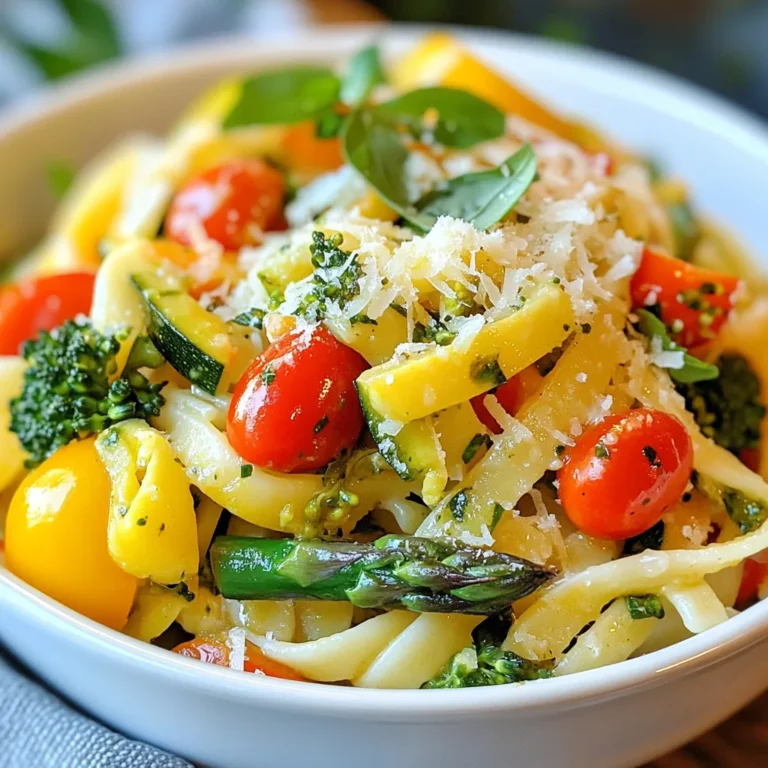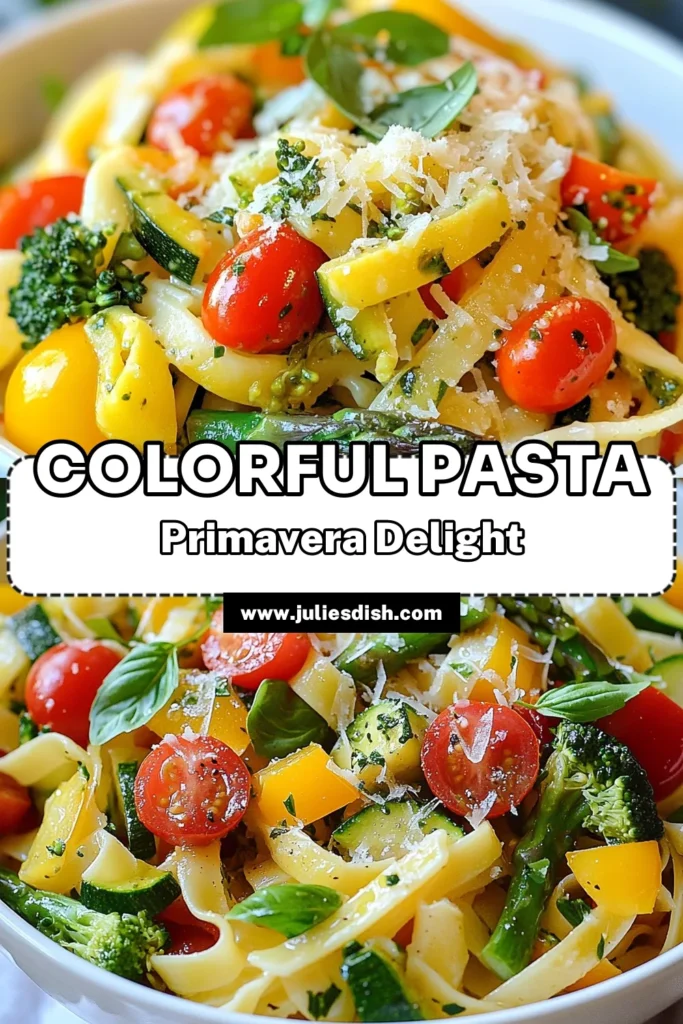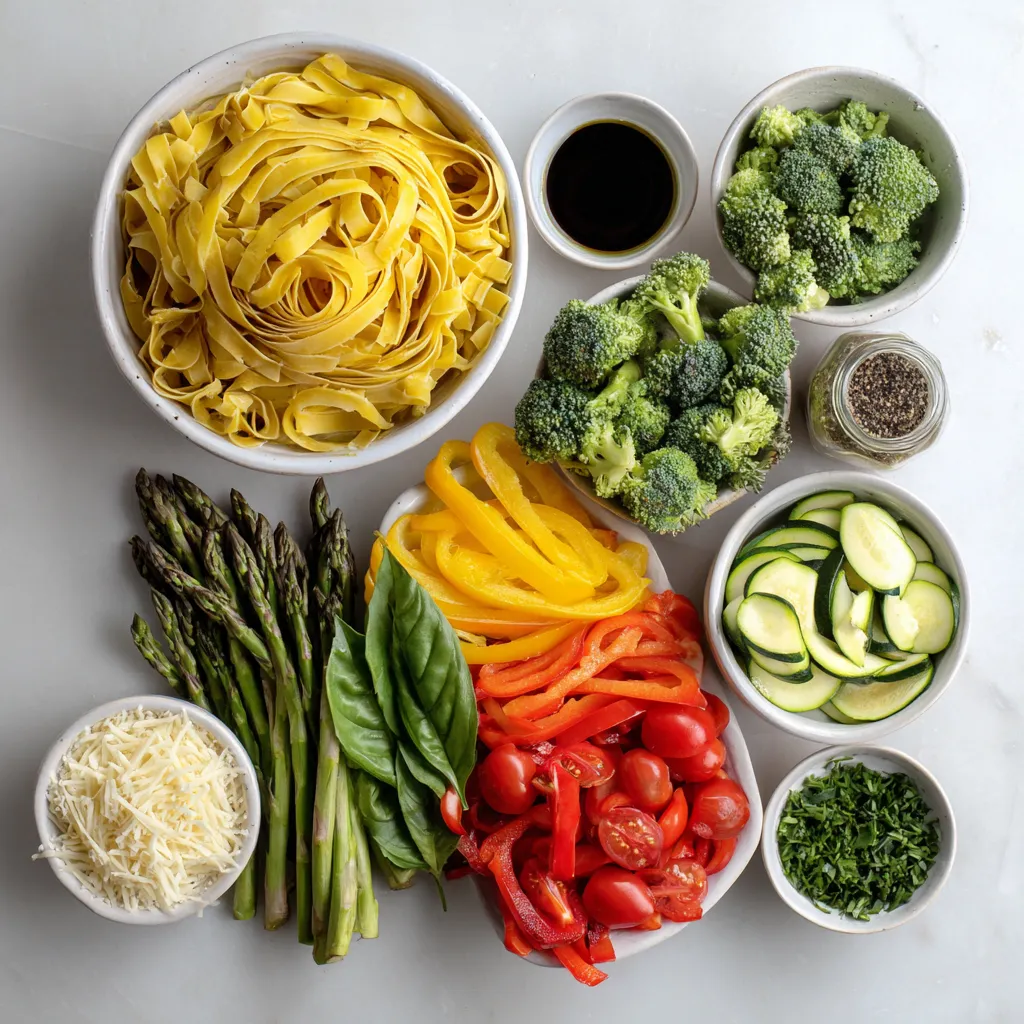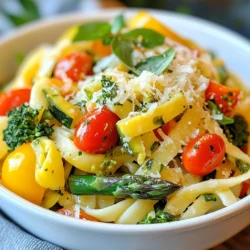WANT TO SAVE THIS RECIPE?
If you’re craving a burst of color and flavor in your meals, Pasta Primavera is your answer. This dish brings fresh vegetables and tasty pasta together for a delightful feast. In this blog post, I’ll share easy steps, helpful tips, and fun variations to make this dish shine. Whether you’re cooking for yourself or hosting friends, let’s create a vibrant meal that you’ll love to serve and enjoy!
Why I Love This Recipe
- Fresh and Colorful: This dish is a feast for the eyes, bursting with vibrant colors from fresh vegetables that make it visually appealing.
- Quick and Easy: With a total time of just 25 minutes, this recipe is perfect for busy weeknights when you want something healthy and delicious.
- Customizable: You can easily swap out vegetables based on your preferences or what you have on hand, making it a versatile recipe.
- Flavorful: The combination of garlic, Italian seasoning, and fresh basil elevates the dish, creating a delightful blend of flavors.
Ingredients
List of Ingredients
– 12 oz fettuccine or penne pasta
– 2 tablespoons olive oil
– 3 cloves garlic, minced
– 1 small zucchini, sliced
– 1 bell pepper (any color), julienned
– 1 cup cherry tomatoes, halved
– 1 cup broccoli florets
– 1 cup asparagus, trimmed and cut into 2-inch pieces
– ½ cup frozen peas (optional)
– 1 teaspoon Italian seasoning
– Salt and pepper to taste
– ¼ cup fresh basil, chopped
– ¼ cup grated Parmesan cheese (optional)
Notes on Ingredient Substitutes
You can swap the pasta for gluten-free options if needed. Zucchini can change to yellow squash. Any bell pepper color works, so pick your favorite. For a vegan dish, skip the cheese or use a dairy-free option. You can also use fresh peas instead of frozen ones.
Importance of Fresh Ingredients
Using fresh ingredients makes your Pasta Primavera shine. Fresh veggies taste better and add crunch. They also look vibrant and colorful on your plate. When you choose fresh herbs, like basil, you get a strong flavor. This dish celebrates the season’s best produce, so always aim for freshness. It helps you create a meal that is not just tasty but also healthy and full of life.

Step-by-Step Instructions
Cooking the Pasta
Start by boiling a large pot of salted water. Once it boils, add 12 ounces of fettuccine or penne pasta. Cook it according to the package instructions until it is al dente. This means it should be firm but not hard. Reserve ½ cup of the pasta water before you drain the rest. Set the pasta aside while you prepare the rest.
Sautéing the Garlic
In the same pot, pour in 2 tablespoons of olive oil and heat it over medium. Once the oil is warm, add 3 cloves of minced garlic. Sauté the garlic for about 1 minute until you smell a nice aroma. You want it fragrant, but be careful not to burn it. Burnt garlic can ruin your dish!
Adding Vegetables and Seasoning
Now it’s time to add the colorful veggies. Toss in 1 small sliced zucchini, 1 julienned bell pepper, 1 cup of halved cherry tomatoes, 1 cup of broccoli florets, and 1 cup of trimmed asparagus cut into 2-inch pieces. If you want more color, add ½ cup of frozen peas. Sauté the vegetables for about 5-7 minutes. They should be tender but still crisp.
Once the veggies are done, add the cooked pasta back to the pot. Pour in the reserved pasta water and sprinkle in 1 teaspoon of Italian seasoning. Toss everything together so the pasta and veggies mix well. Season with salt and pepper to taste. Finally, if you chose to use peas, add them now along with ¼ cup of chopped fresh basil. Toss it all again for about 2 minutes. You want everything to be hot and well combined.
Tips & Tricks
Best Practices for Cooking Pasta al Dente
To cook pasta al dente, start with plenty of water. Use a big pot and add salt. Bring the water to a rolling boil. Add the pasta and stir it. Check the pasta a minute before the package time ends. It should be firm but not hard. Drain the pasta but save some water. This water helps the sauce stick later.
How to Perfectly Sauté Vegetables
When sautéing vegetables, use a large skillet. Heat the oil over medium heat. Add minced garlic first, as it gives great flavor. Sauté it for just one minute. Then add your sliced vegetables. Stir them often for even cooking. Aim for a colorful mix that stays crisp. Cook for five to seven minutes until they soften but still have a bite.
Serving Suggestions for Pasta Primavera
To serve Pasta Primavera, use shallow bowls to show off the colors. Garnish with fresh basil for a nice pop. A light drizzle of olive oil adds shine and flavor. You can also sprinkle Parmesan cheese on top for extra taste. For a personal touch, serve with a side salad or crusty bread. This makes the meal feel special and complete.
Pro Tips
- Tip Title: Use Seasonal Vegetables: Incorporate seasonal vegetables for the freshest flavors and vibrant colors in your pasta primavera.
- Tip Title: Perfect Pasta Texture: Cook pasta just until al dente for the best texture that holds up well against the sautéed vegetables.
- Tip Title: Customize with Protein: Add grilled chicken, shrimp, or tofu for an extra protein boost and to make the dish more filling.
- Tip Title: Enhance Flavor with Cheese: Use freshly grated Parmesan cheese for a richer flavor, or try a sprinkle of feta for a different twist.

Variations
Gluten-Free Pasta Primavera
You can easily make gluten-free pasta primavera. Just swap regular pasta for gluten-free options. Look for gluten-free fettuccine or penne at your store. These alternatives have great taste and texture. They cook similarly, so follow the package instructions. This way, everyone can enjoy this dish without worry.
Vegan Alternatives for Dairy Products
To make this dish vegan, skip the Parmesan cheese. You can add nutritional yeast for a cheesy flavor. It gives a nice umami taste without dairy. Try using coconut cream or cashew cream for creaminess. These options will keep the dish tasty and rich without using animal products.
Seasonal Vegetable Swaps
Feel free to change up the veggies based on what’s in season. In spring, use fresh peas and asparagus. In summer, add bell peppers and zucchini. Fall allows for squash and carrots. Winter brings root vegetables like carrots and parsnips. This keeps your pasta primavera fresh and exciting all year round!
Storage Info
How to Store Leftover Pasta Primavera
Store leftover pasta primavera in an airtight container. Let it cool down first. This helps keep the pasta fresh. Place it in the fridge within two hours of cooking. It will stay good for up to three days. If you plan to eat it later, make sure to separate any cheese. It can make the dish soggy.
Tips for Reheating
To reheat your pasta primavera, use the stove or microwave. If using the stove, add a splash of water or olive oil. This helps keep the pasta moist. Heat on low, stirring often until it warms up. For the microwave, cover the dish with a damp paper towel. This keeps it from drying out. Heat in short bursts, checking often.
Freezing Pasta Primavera: What to Know
You can freeze pasta primavera for later use. First, let it cool completely. Pack it in a freezer-safe container or bag. Remove as much air as possible to prevent freezer burn. It can last for up to three months in the freezer. When ready to eat, thaw it in the fridge overnight. Reheat as usual for best results.
FAQs
What is Pasta Primavera?
Pasta Primavera is a fresh pasta dish. It features colorful vegetables and pasta. The name means “spring pasta” in Italian. This dish celebrates the bright flavors of spring veggies. You can use any pasta like fettuccine or penne. It’s a perfect meal for a warm day or light dinner. The mix of veggies adds great taste and nutrition.
Can I make Pasta Primavera ahead of time?
Yes, you can prepare Pasta Primavera ahead of time. Cook the pasta and veggies, then store them separately. Keep the pasta in the fridge for up to three days. Store the veggies in an airtight container. When ready to eat, simply reheat everything together. Add fresh basil and cheese just before serving for the best flavor.
What are the best vegetables to use in Pasta Primavera?
The best vegetables are those that are fresh and crisp. You can use zucchini, bell peppers, and cherry tomatoes. Broccoli and asparagus are also great choices. Try adding peas for a pop of sweetness. Seasonal veggies like snap peas or spinach work well too. Feel free to mix and match based on your taste.
We covered a lot about Pasta Primavera. Fresh ingredients make a big difference in taste. Cooking pasta just right enhances the dish. Sautéing garlic and veggies brings out great flavors. Don’t forget your serving tips and fun variations.
Remember, you can swap ingredients to fit your needs too. With these tips, you can store leftovers well and reheat them perfectly. Enjoy your Pasta Primavera, and make it your ow
Vibrant Pasta Primavera
A colorful and fresh pasta dish loaded with seasonal vegetables.
Prep Time 10 minutes mins
Cook Time 15 minutes mins
Total Time 25 minutes mins
Course Main Course
Cuisine Italian
Servings 4
Calories 350 kcal
- 12 oz fettuccine or penne pasta
- 2 tablespoons olive oil
- 3 cloves garlic, minced
- 1 small zucchini, sliced
- 1 bell pepper any color, julienned
- 1 cup cherry tomatoes, halved
- 1 cup broccoli florets
- 1 cup asparagus, trimmed and cut into 2-inch pieces
- ½ cup frozen peas (optional)
- 1 teaspoon Italian seasoning
- to taste salt and pepper
- ¼ cup fresh basil, chopped
- ¼ cup grated Parmesan cheese (optional)
In a large pot of boiling salted water, cook the pasta according to package instructions until al dente. Reserve ½ cup of the pasta water, then drain the rest and set the pasta aside.
In the same pot, heat the olive oil over medium heat. Add the minced garlic and sauté for about 1 minute until fragrant, being careful not to let it burn.
Toss in the zucchini, bell pepper, broccoli, asparagus, and cherry tomatoes. Sauté for about 5-7 minutes, or until the vegetables are tender yet crisp.
Add the cooked pasta to the vegetable mixture. Pour in the reserved pasta water, add Italian seasoning, and toss well to combine. Season with salt and pepper to taste.
If using, add the frozen peas and fresh basil, tossing everything together until well mixed. Cook for an additional 2 minutes to heat everything through.
Plate the pasta primavera and sprinkle with grated Parmesan cheese if desired.
Serve in bowls, garnished with a sprinkle of fresh basil and a light drizzle of olive oil for an added touch.
Keyword healthy, pasta, spring, vegetables
WANT TO SAVE THIS RECIPE?





